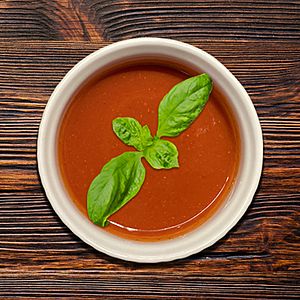Chashni facts for kids

Chaashnig Hot Sauce
|
|
| Type | Hot sauce |
|---|---|
| Course | Condiment |
| Place of origin | Iran |
| Main ingredients | Chili Peppers |
Chashni or Chaashni is a word with two main meanings. In Persian, it means a special sauce or spice added to food. This helps to make the food taste better or gives it a new flavor. Think of it like a secret ingredient that famous chefs use!
In Hindi, Nepali, Urdu, and Afghan languages, Chashni means a sweet sugar syrup. This syrup is used in many delicious sweets and desserts. It can be thin or thick, depending on what kind of sweet it's for.
Contents
What is Chashni?
Chashni can be many things, depending on where you are. It's often a special addition that makes food more exciting.
Chashni as a Condiment
A condiment is something you add to food to change its taste. Some chashnies are used while cooking. For example, saffron, barbecue sauce, teriyaki sauce, soy sauce, and pomegranate juice are all used this way. They mix into the food as it cooks.
Other chashnies are added right before you eat. You might put ketchup, mustard, mayonnaise, Sriracha, or hot sauce on your sandwich. These are also types of chashni. Using the right chashni can make any meal or salad much tastier!
Chashni as a Sugar Syrup
In places like North India, Pakistan, Nepal, and Afghanistan, chashni is a sweet sugar syrup. This syrup is usually thin enough to swirl around. It can have different flavors, like rose or saffron.
To make this chashni, you boil water with sugar. You stir it until it reaches the right thickness.
- A thin syrup (called "single thread") is used for foods that need to soak up the sweetness.
- A thicker syrup (called "two thread") helps sweets set and hold their shape.
- A very thick syrup (called "three thread") is used for making ground sugar.
Where Does the Word "Chashni" Come From?
The word "Chaashni" has a long history. It comes from ancient languages. In Old Persian, it meant "to behold," "to see," or "to taste." Over time, in Middle Persian, it came to mean "taste" or "tasting." So, the word itself is all about experiencing flavor!
A Look Back: Chashnies in Iran
People have been using special ingredients to flavor their food for a very long time. In ancient Persia (which is now Iran), some important chashnies were used.
Saffron: A Golden Spice
Saffron is a very special spice. It was grown in Persia thousands of years ago. Ancient Persians used saffron for many things:
- As a bright yellow dye for clothes.
- As a sweet perfume.
- As a medicine, mixed into hot teas to help with sadness.
- To spice up foods and teas.
They even mixed saffron in water with sandalwood to wash their bodies after hard work in the hot sun. Later, a famous leader named Alexander the Great used saffron a lot. He mixed it into his teas and ate saffron rice. He even put saffron in his warm bath water, believing it would help heal his wounds.
Other Ancient Persian Flavors
- Golpar (also known as Persian hogweed) is a spice that comes from Iran. It has been used in Persian cooking since ancient times.
- Pomegranate juice and pomegranate molasses have also been used in Iranian food for a very long time. Pomegranates originally came from Iran, so they were a natural choice for flavoring dishes.
Today, people all over the world use many different chashnies. Things like ketchup, mayonnaise, paprika, and hot sauces are now common on dining tables everywhere. They help satisfy all the different tastes people have!

